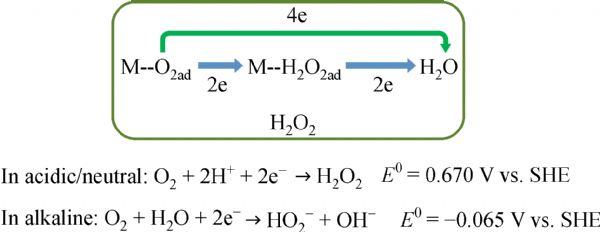

New insight into effect of potential on degradation of Fe-N-C catalyst for ORR
Received date: 09 Jul 2020
Accepted date: 11 Sep 2020
Published date: 15 Jun 2021
Copyright
In recent years, Fe-N-C catalyst is particularly attractive due to its high oxygen reduction reaction (ORR) activity and low cost for proton exchange membrane fuel cells (PEMFCs). However, the durability problems still pose challenge to the application of Fe-N-C catalyst. Although considerable work has been done to investigate the degradation mechanisms of Fe-N-C catalyst, most of them are simply focused on the active-site decay, the carbon oxidation, and the demetalation problems. In fact, the 2e− pathway in the ORR process of Fe-N-C catalyst would result in the formation of H2O2, which is proved to be a key degradation source. In this paper, a new insight into the effect of potential on degradation of Fe-N-C catalyst was provided by quantifying the H2O2 intermediate. In this case, stability tests were conducted by the potential-static method in O2 saturated 0.1 mol/L HClO4. During the tests, H2O2 was quantified by rotating ring disk electrode (RRDE). The results show that compared with the loading voltage of 0.4 V, 0.8 V, and 1.0 V, the catalysts being kept at 0.6 V exhibit a highest H2O2 yield. It is found that it is the combined effect of electrochemical oxidation and chemical oxidation (by aggressive radicals like H2O2/radicals) that triggered the highest H2O2 release rate, with the latter as the major cause.

Yanyan GAO , Ming HOU , Manman QI , Liang HE , Haiping CHEN , Wenzhe LUO , Zhigang SHAO . New insight into effect of potential on degradation of Fe-N-C catalyst for ORR[J]. Frontiers in Energy, 2021 , 15(2) : 421 -430 . DOI: 10.1007/s11708-021-0727-2
| 1 |
Martinez U, Komini Babu S, Holby E F,
|
| 2 |
Konnerth H, Matsagar B M, Chen S S,
|
| 3 |
Yang L J, Shui J L, Du L,
|
| 4 |
Banham D, Ye S Y. Current status and future development of catalyst materials and catalyst layers for proton exchange membrane fuel cells: an industrial perspective. ACS Energy Letters, 2017, 2(3): 629–638
|
| 5 |
Zhang L, Si R, Liu H,
|
| 6 |
Liu M L, Zhao Z P, Duan X F,
|
| 7 |
Chang Q W, Xu Y, Zhu S Q,
|
| 8 |
Guo Y, Tang J, Henzie J,
|
| 9 |
Tan H, Li Y, Kim J,
|
| 10 |
Tan H, Tang J, Henzie J,
|
| 11 |
Cai J J, Zhou Q Y, Liu B,
|
| 12 |
Zhang X, Chen A, Zhong M,
|
| 13 |
Chueh C C, Chen C I, Su Y A,
|
| 14 |
Banham D, Choi J Y, Kishimoto T,
|
| 15 |
Doustkhah E, Lin J, Rostamnia S,
|
| 16 |
Liao Y T, Nguyen V C, Ishiguro N,
|
| 17 |
Xia W, Tang J, Li J,
|
| 18 |
Jasinski R. New fuel cell cathode catalyst. Nature, 1964, 201(4925): 1212–1213
|
| 19 |
Jahnke H, Schönborn M, Zimmermann G. Organic dyestuffs as catalysts for fuel cells. In: Schäfer F P, eds. Physical and Chemical Applications of Dyestuffs. Berlin, Heidelberg: Springer, 1976, 61
|
| 20 |
Lefèvre M, Proietti E, Jaouen F,
|
| 21 |
Yarlagadda V, Carpenter M K, Moylan T E,
|
| 22 |
Cheng N, Zhang L, Doyle-Davis K,
|
| 23 |
Shao Y Y, Dodelet J P, Wu G,
|
| 24 |
Lefevre M, Dodelet J P. Fe-based catalysts for the reduction of oxygen in polymer electrolyte membrane fuel cell conditions: determination of the amount of peroxide released during electroreduction and its influence on the stability of the catalysts. Electrochimica Acta, 2003, 48: 2749–2760
|
| 25 |
Artyushkova K, Serov A, Rojas-Carbonell S,
|
| 26 |
Muthukrishnan A, Nabae Y, Okajima T,
|
| 27 |
Zheng W, Wang L, Deng F,
|
| 28 |
Choi C H, Lim H K, Chung M W,
|
| 29 |
Goellner V, Armel V, Zitolo A,
|
| 30 |
Kumar K, Dubau L, Mermoux M,
|
| 31 |
Kusoglu A, Weber A Z. New insights into perfluorinated sulfonic-acid ionomers. Chemical Reviews, 2017, 117(3): 987–1104
|
| 32 |
Yang L M, Bai Y Z, Zhang H J,
|
| 33 |
Abe H, Hirai Y, Ikeda S,
|
| 34 |
Ma R, Lin G, Zhou Y,
|
| 35 |
Wang W, Jia Q Y, Mukerjee S,
|
| 36 |
Lu Z Y, Chen G X, Siahrostami S,
|
| 37 |
Macauley N, Papadias D D, Fairweather J,
|
| 38 |
Chen L N, Yu W S, Wang T,
|
| 39 |
Choi C H, Baldizzone C, Grote J P,
|
| 40 |
Choi C H, Choi W S, Kasian O,
|
| 41 |
Cai R, Abdellaoui S, Kitt J P,
|
| 42 |
Li J, Zhang H, Samarakoon W,
|
| 43 |
Ren G Y, Gao L L, Teng C,
|
/
| 〈 |
|
〉 |